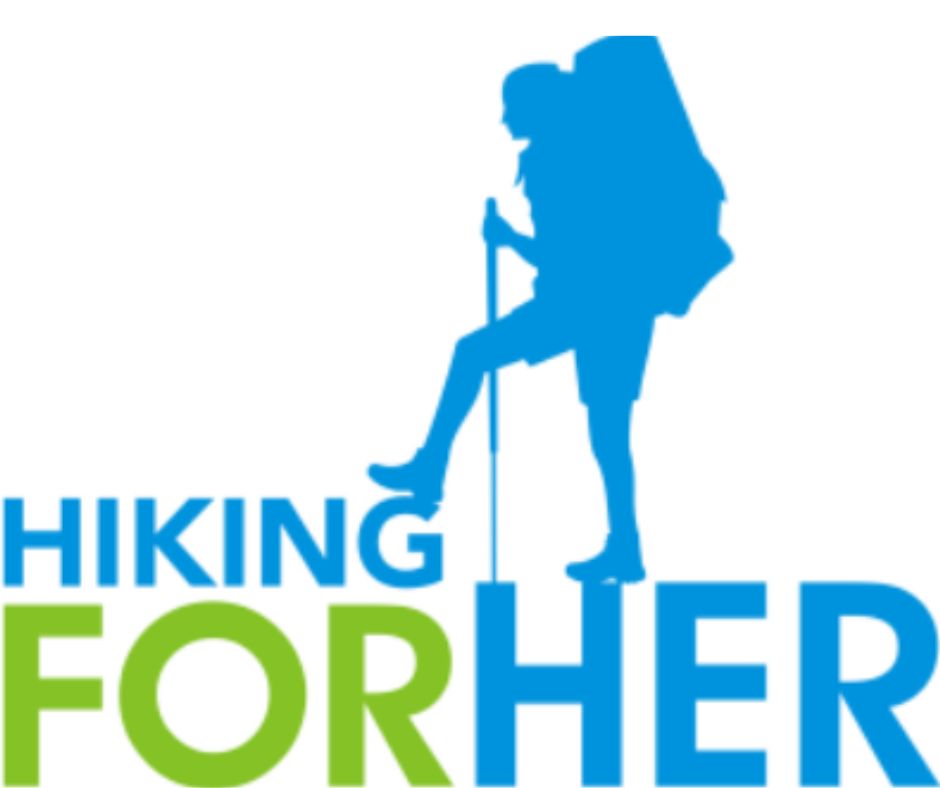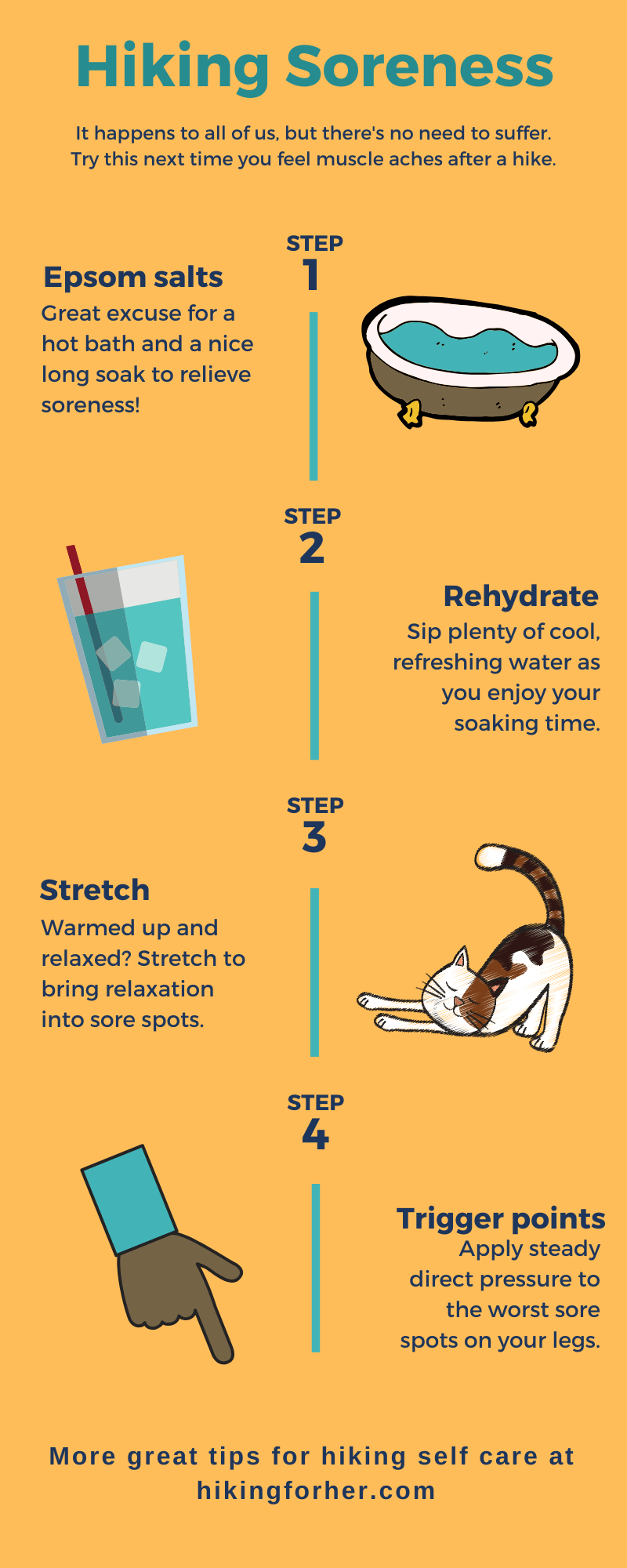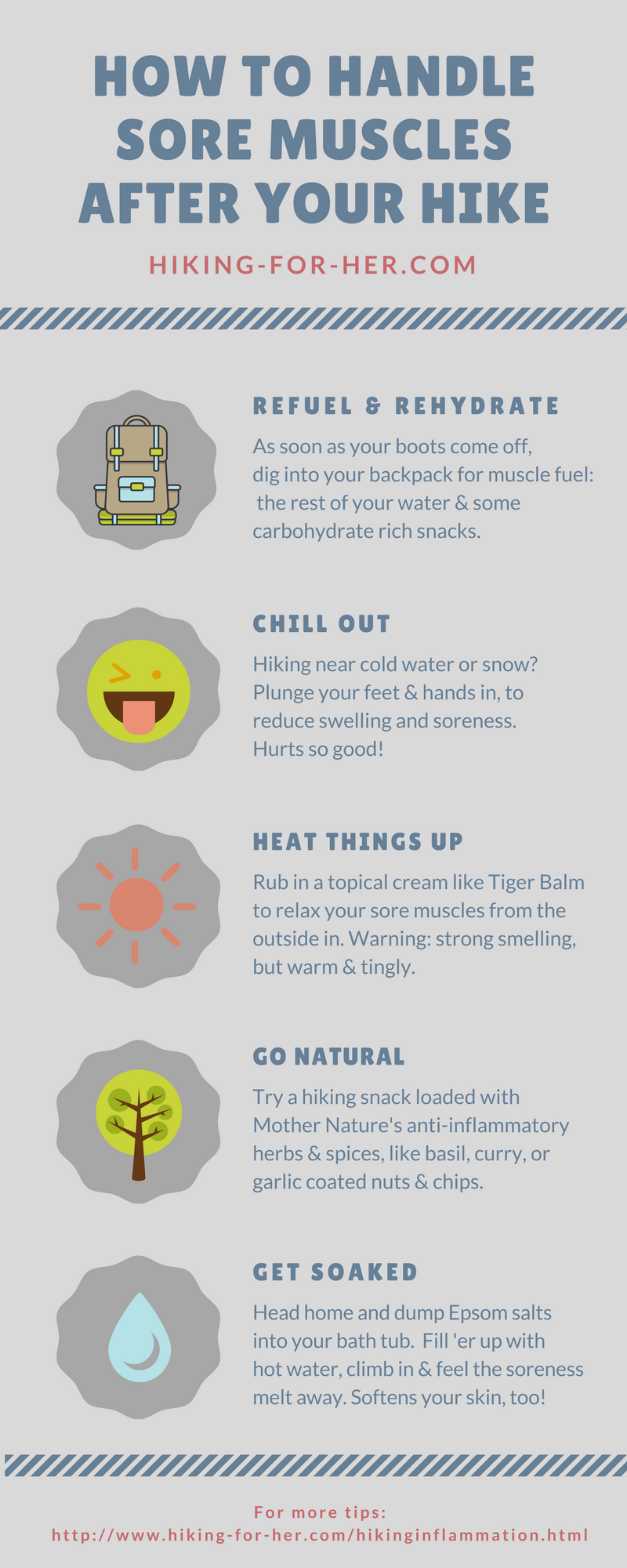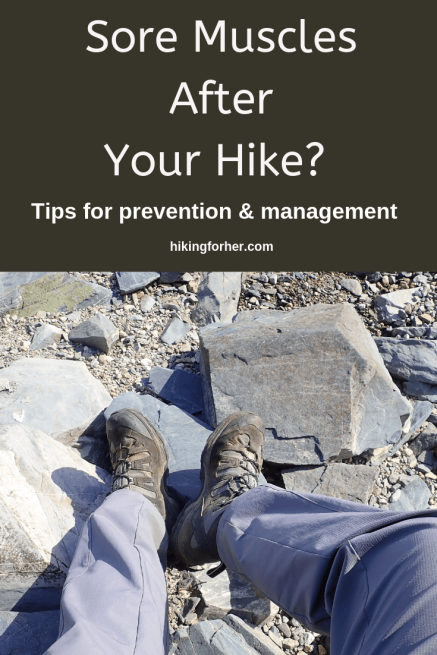Hiking Soreness:
Here's What A Hiker Can Do
By Diane Spicer
This Hiking For Her guide to coping with hiking soreness covers a lot of ground for you.
Each of these links will take you to a specific section of the guide.
- Your hiking backpack's effect on soreness
- Stretches for happier hiking muscles
- Improving your muscle strength
- Hydration
- Hiking nutrition hacks
- Ergonomic fixes using the right gear like poles
- How to handle inflammation
- Tips for dealing with soreness
There a lots of things you can do about hiking soreness!
Hiking soreness and pain: the price of admission to the trail, right?
Especially sore knees!
Hey!
You don't have to be fatalistic about how much pain and stiffness you have to endure the day after a hike.
- You can decrease your post hike recovery time.
- If you're in a hurry, read these tips.
And you shouldn't be fearful about whether you can get through a multi-day hiking trip in one piece.
There are many ways to stack the deck in your favor, and against muscle soreness.
Let's take a look at some of the best ways to handle - and even prevent - your hiking muscle soreness.
Because walking with sore legs is no fun, especially on a hike you really want to do.
Here's the burning but correct question
about hiking soreness
How can you cut the odds of muscle soreness on your next hike?
And the answer is:
Pay close attention to every single factor you can to avoid that hiking soreness.
Things like:
- choosing the right hiking gear that fits you
- wearing high quality hiking socks and trail footwear
- correct weight distribution of your backpack through your spinal column, hips, and knees
- conditioned and warmed up muscles
- correct hiking techniques & pacing for terrain and distance
- ergonomic hiking aids
- anti-inflammatory actions
Use that "UP" arrow over there on the right to zoom up to the search box.
Find detailed tips on any and all these important hiking topics to cut down your hiking soreness.
Wait!
I forgot two even more important factors:
Embrace the reality that what you eat and drink on a hike can contribute to how you feel the next day.
Still with me?
You didn't expect an easy (mask-the-problem) fix like "pop an aspirin", did you?
Let's get started on a closer look at this touchy subject of post hike muscle soreness.
Not in the mood for details?
Tips for dealing with muscle soreness like achy calves are all yours right here.
Plus these:
If you're in the mood for diving into the details of how to reduce your muscle soreness after a hike, I have a suggestion.
Prevention is a prudent place to begin.
Here's another tip.
Head over to post hike recovery tips. Spend some time soaking up strategies for what to do when you're sore after a hike.
If the pack fits, wear it proudly
to prevent hiking soreness!
What's the thing most associated with a hiker?
A backpack, right?
Consider this:
Are you asking your back and legs to lug around a top heavy backpack with a poor fit?
- If your pack doesn't fit, don't wear it!
If it's a worn out second hand store "bargain" (not high enough quality to transfer weight to your lower body), say it with me:
- DON'T WEAR IT!!!
Read these tips on the best hiking backpacks instead.
Could it be this easy to prevent hiking soreness?
Prevention of hiking soreness can be as simple as adjusting the straps on your favorite pack.
- You've taken the time to play with all the "bells and whistles" on your pack, haven't you?
- You've stood in front of a full length mirror, with a hand mirror so you can see your back side, to scope out whether the pack sits too high, hugs too tightly, is too wide... haven't you?
- And you've asked your trail buddy to yank or release the straps you can't reach, until the pack fits just right on you... right?
(Nobody is keeping score except your sore, sore muscles.)
Your backpack cannot transfer weight to your pelvis and legs if you fail to fine tune the straps.
So fiddle around with every strap until there's no stress or tension:
- in your neck
- your shoulders
- your lower back
- your hard working knees
Do you experience
chronic hiking soreness in your body?
Soreness in the same places over and over again after a hike is a clue.
It indicates potential pack problems (or posture problems - a separate topic).
Sore knees could be any number of things!
- Ditto for your sad sore feet
- Or sore calves
So before throwing away your favorite pack, try this.
Play around with its straps and belts and buckles, to customize it for the contours of your body.
Also try packing it differently.
If that doesn't work, pass it along to some other hiker.
Vow to pay more attention to your next backpack shopping trip, using these tips:
Warm up those muscles to prevent hiking soreness -
and then hit the trail
Another thing to consider (and you're gonna hate this):
- Have you stretched before charging up the trail?
- How about specific back stretches?
I know, I know, it's a pain (pun intended). Who wants to burn daylight standing around stretching?
And the danger of being mistaken for a yoga instructor is very real.
- If you are one, hand out your business cards to passing hikers.
Stretching helps!
After decades of trail time, I firmly believe in stretching.
Here's why:
Muscles need a clue that you are about to use them to get to the top of that pile of rocks.
It's simple courtesy:
- Stretching will deliver more blood to them, lengthen their fibers, tell them to loosen up a little - time to go!
- In return, they perform at their peak, and without complaint.
Nice deal for a small time investment in stretching, don't you agree?
Strengthen AND stretch to prevent muscle soreness
Stretching weak muscles doesn't do much good to prevent muscle soreness.
I'm assuming you're kind enough to take your large skeletal muscle groups on daily short romps:
- Take the stairs (two at a time?) and shun the elevator.
- Enjoy a brisk 15 minute walk at lunch time, and again after dinner.
- Plan some sort of aerobic exercise (dance, brisk walk, run, bike, swim) several times per week. Aim for at least 30 minutes each time.
- Jog in place while watching a movie at home.
How about this new daily habit?
- Lie down on the floor and do
whole body stretches for a few minutes.
All that means is get in touch with where your body wants to stretch, and where it feels tight.
- Channel your inner cat and relish the deliciousness of stretched muscles.
- If you're into yoga, do some cat-cow poses until you feel your back relax.
If that seems like a silly waste of time, how much do you want to leave sore muscles in your past?
Simple works!
A note to keep it real
Not everyone recommends stretching before a hike.
If you're a limber twenty something who is into yoga, you can get away with skipping it.
- For a few years.
- Until the "bill" comes due.
Older or less limber hikers would do well to pay attention to warming up before tackling the trail.
It's such a simple, free way to avoid, and relieve, back pain.
- Do you respect your body enough to do it?
Improve your muscle strength
to prevent hiking soreness
A few biological facts to ponder:
- Strong muscles recover faster from exercise.
- They burn fuel with more efficiency during a hike.
- Strength makes you feel more balanced - and thus safer - on tricky footing.
Try these strengthening ideas:
- Moderate weight training 3X per week (start with 2 pound weights and work your way up to 15 pounds)
- Resistance exercises (stretchy bands are fun!)
- Brisk walking with vigorous arm swings
- Swimming (especially in warm salt water)
- Biking at alternating speeds
...all are excellent, low cost ways to prevent hiking soreness.
Are you a social creature?
You can:
- join a spin class (it might hurt at first, but think of your strong legs!!)
- find a dance class or yoga group at a local YMCA
- commit to a daily brisk walk with a neighbor (wear a backpack with a bit of weight in it)
- join a hiking group that pushes you a bit past your comfort zone.
Start somewhere, and (OK, you knew this was coming)...
Just Do It!
An example
My routine, as an example:
- Every morning before breakfast I spend ten minutes lifting 10 pound weights. Nothing fancy, just a brief work out for all major muscles on my upper body. I began with 3 pounds and gradually worked my way up to my max.
- Every afternoon I walk several miles up and down hills (4 - 5 miles)/ I breathe deep and swing my arms to balance my legs and keep my aerobic capacity high.
- I stretch and build core strength with yoga twice per week, either in a low cost class or by myself at home.
- I hike or snowshoe every weekend, weather and schedule permitting.
Once in awhile I drag out the resistance bands, but weights and walking do it for me at the ripe old age of 60+.
I follow this policy like an ant on a sugar trail, because I know it pays off year after year on the trail.
So my plea to you is this:
Put together your own personal program.
Start small, or the muscle soreness of an ambitious plan will defeat you!
But start.
Today.
Right now.
You'll know you're making progress when you push yourself a bit on the trail and you feel fine the next day.
- No more back pain or sore feet for you!
Ignore hiking hydration at your own risk!
What's the connection between hydration and hiking soreness?
Water is a need for your cellular biochemistry to work well.
It's tagged the universal solvent because it
- flushes away toxins
- contributes to the building of energy molecules
- keeps muscle fibers and soft tissue compartments from sticking together while contracting
I am not overstating it when I call water a miracle substance, so give your body plenty of it.
Doesn't it make sense when your thirst drive kicks into high gear on a hiking trail?
- Drink early and often on the trail.
- A hydration backpack gives you unlimited sipping opportunities.
How much water makes sense
to cut down on hiking soreness?
There's a good deal of debate about how much water to drink on a hike is the RIGHT amount.
I've heard people spout "facts" which advocate consuming liters of water a day.
- Hyponatremia is a concern with this approach. It's defined as low sodium levels in the bloodstream resulting in physical problems.
Instead, be realistic.
- Water is heavy. You can only carry so much of it.
- Try to stay ahead of your thirst signal by stopping every hour to hydrate.
Tip:
If you're not much of a water drinker to begin with, try to double the amount you drink at home over the next few months.
Coffee, tea (unless it's herbal), sweet carbonated drinks, alcoholic beverages don't count as daily water intake. They can even work against you because they pull water out of your bloodstream and into your urine.
Sip water, plain water, at every opportunity.
Or jazz it up with lemon, lime and cucumber slices, or fresh herbs (I love lemon balm and mint, personally).
After awhile, you won't want anything else in your hydration plan (except a cup of tea once in awhile).
Your kidneys will breathe a sigh of relief.
- Your chance of kidney stones has decreased.
Your heart will zing with joy.
- Normal blood volume = more efficient strokes for your heart muscle.
Your skeletal muscles will perform with less soreness.
- Fibers don't stick together, bunch up, or spasm.
- Muscle compartments can glide past each other with ease.
Consider adding electrolytes
Your body uses electrolytes to get its work done.
Electrolytes are important charged particles called ions, such as sodium, potassium, calcium, chloride.
When you sweat, you lose electrolytes as salt (lick your sweaty forearm for proof).
So if you're tackling a tough trail, you might want to add some electrolytes to your water bottle.
A quick, easy experiment to run:
Enhance your hiking water and see how you feel the next day.
- I tried this approach a few years back.
- Amazing how my endurance improved and my muscle soreness diminished.
Ultima is the brand of powdered electrolytes I prefer.
I'm partial to the lemon flavor, but they're all tasty.
I use this less expensive bulk jar to load up my water bottles before each hike.
I also carry small packets in my lunch sack as a precaution on really hot or vigorous hikes.
Trail tip:
Throw a few of those hydration "sticks" into your emergency kit. You never know when you'll need them, and the sealed packages stand up to heat and moisture for many seasons.
How to tell when you're dehydrated
Nothing could be more simple: look at the color of your urine.
If you pee small amounts of dark urine with a strong odor, you need more water immediately!
The next time you pee, your urine should be lighter in color and you should produce a lot more.
If not, keep drinking water until plenty comes back out!
As you eat, so goes the hike
Muscles need building blocks to continue to perform their contractions and relaxations.
If you've been skimping on protein, your muscles can't perform optimally.
So you have to go beyond staying hydrated.
Look at your nutrient intake before, and during, each hike if you want to avoid or reduce hiking soreness.
Carbohydrates (carbs) will give you fast fuel.
"Eat whole grains before your hike, and again at lunchtime." is a wise hiking mantra.
Why?
Carbs are the key to sustained energy on the hiking trail!
- Here are the best rice choices as a backpacker to replenish your carb supply at dinner time.
But you'll need protein, protein, protein after a hike.
Why?
To rebuild your muscles (they undergo micro-tears as you hike).
Which type of protein, and how much, depends upon you as an individual.
- Here are the best protein sources for hikers, whether day hiking or backpacking.
If you want to get into the nitty gritty calculations, I've got something that can help.
I've written some Fast Fact booklets based on the type of hiking you do.
Two more anti hiking soreness
nutrition strategies for you to try
- Add the best antioxidants for hikers into your hiking menus. They are powerful inflammation fighters.
- Eat the best nuts as not only protein sources, but to get healthy fats for enhancing your immunity.
Ergonomic approaches to avoid hiking soreness
How you use your body on the trail will also determine how sore you feel after a hike.
If you experience pain after hiking, use these Hiking For Her's best ergonomic tips and see if they help you.
Work with the terrain
You know your body's limitations.
Honoring them will keep you out of the land of extreme hiking soreness.
Example:
I know that if I jump into full blown hikes after the usual winter weather related break, I'm gonna be sore.
So why not start off with some training hikes?
- Soreness will diminish as muscles become accustomed to regular hiking routines.
I also know this fact.
Steep down hill trail work is NOT good for my knees any time of year.
That is why I consult topographical maps before I take on a new hike.
Armed with the facts, I avoid the terrain which I know is bad for my aging, but oh-so-important knees.
I know to budget in more time for descent.
- And if an alternate route exists, I take it.
Bottom line:
Know what you're up against, and pace yourself.
Use trekking poles to your advantage
But I go one better to protect my knee cartilage:
- Here's why I use hiking/trekking poles on every hike, without fail.
You will run into hikers (just don't run over them as they hobble along) who scoff at using poles.
- Usually, those hikers have plentiful, young cartilage and tend to be lean.
- Or they're old school hikers who can't wrap their minds around a new trick.
But time has a way of erasing everyone's cartilage.
Why take a pounding on your precious joints when you don't have to?
Test hiking poles for yourself
Super simple to gather this data:
- Rent or borrow a pair of hiking poles and hike downhill for at least half a mile.
- Turn around and go the other way.
How do you feel the next day?
An added benefit I like about using trekking poles?
The upper body workout they force me into getting as a side benefit.
Not to mention the feeling of security and balance they provide on narrow, rocky trails.
I've tried several pairs of poles.
They've proven themselves to be tough, easy to collapse or extend, and lightweight: Black Diamond Trail Pro shock absorbing poles.
Should you use one hiking pole, or two, on a hike?
Another area of debate: should you use one pole, or both?
I've used one pole, and my rhythm and balance feels "off" during and after the hike.
Also, the side of my body using the pole (usually my dominant right side) seems more tired after the hike.
And hiking soreness concentrates in that shoulder.
Thus, I'm a believer in using both poles.
But again, experiment to find what feels best for you.
Try a quality pair of hiking insoles
Sore feet are a misery best avoided on the hiking trail of life.
If you're an older hiker, the fat pads on your feet are disappearing. Don't get me started on the unfairness of the location.
It's a smart strategy to replace the insoles in your trail footwear with more arch support.
Read my tips here:
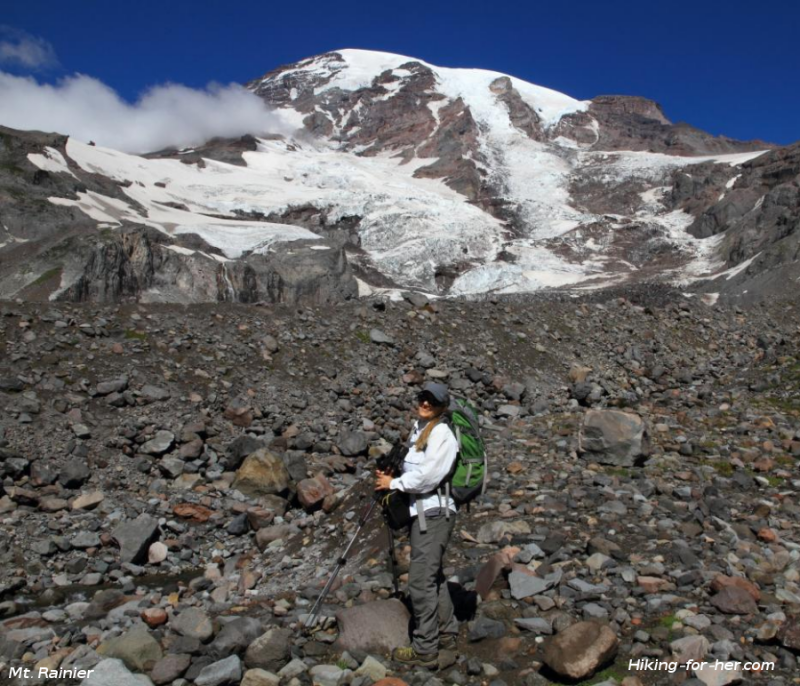 Hiking poles help you conquer the uphill sections!
Hiking poles help you conquer the uphill sections!
Inflammation - a hiker's friend or foe?
Inflammation is a natural defense mechanism to fight general threats to your body.
That includes the soreness that comes with hiking.
The media has trained us to fear inflammation and sore muscles. We're taught to reach immediately for pain relief.
But is inflammation the enemy?
Some hiking inflammation is normal
Let's use a medical definition.
Inflammation is a non-specific response to threat. Your body uses it to address trauma, injury, or over-use syndromes.
These are things a hiker knows a little something about.
Have you ever noticed its cardinal signs after a hike?
- pain (a bit more insistent than soreness)
- heat
- redness
- stiffness
- swelling
If you experience any of these that seem beyond expected mild soreness, don't ignore them.
Inflammation is a message from your body, asking for corrective measures.
Heed the message!
What needs to change?
- Do you need to change your boots or try different combinations of socks?
- Should you should remove your boots and socks at your lunch spot, to allow circulation to return to your feet?
- What about soaking in a cold stream, or soaking your bandanna in it and applying it to your neck or legs? Hydrotherapy is effective for encouraging blood exchange between your core and your limbs.
- Re-read the pack and hiking poles information above. Then experiment with some changes in fit, pole length and technique.
- Admit that you do need to warm up more with stretches before you tackle steep slopes. Try it!
- If you don't like the way you feel post-hike, your hiking technique needs to change.
- Swollen feet or swollen fingers after a hike can be a normal amount of inflammation, or maybe not.
- Listen to your sore toes and make some chances.
Whatever the root cause of the hiking soreness problem, be smart and proactive.
Invest time into identifying and fixing it before it goes chronic on you.
Chronic pain means you risk permanent injury if you don't stop.
That's why I'm a prevention advocate. Listen to the feedback your body gives you after a hike.
Then do something about it.
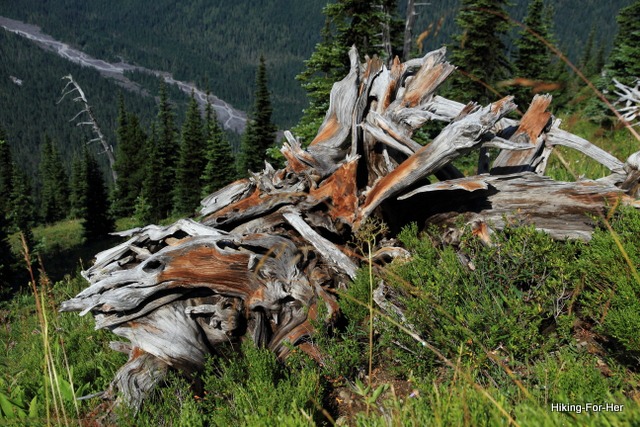 You don't want a hard, brittle, battered body like this tree stump, do you?
You don't want a hard, brittle, battered body like this tree stump, do you?
Best tips for dealing with hiking soreness right now
So much for prevention.
Now let's tackle what to do if you've got major muscle soreness bugging you during a multi-day trip.
Or even after a day hike.
As a hiker, you have to keep going despite the discomfort.
Here's where I am in danger of losing you, because I'm still not advising you to reach for the pain relief pills.
Instead, I'm going to recommend self massage for your major muscle groups (the ones you can reach).
Uh, what now?
Depending on your familiarity with massage, I'm expecting one of two reactions:
- A loud groan ("Isn't that somewhat inappropriate?")
-or-
- An enthusiastic nod of agreement followed by "But I don't have time for that".
Many Americans can't see the value of therapeutic massage.
- If you're from a culture that realizes the value of soft tissue manipulation, bravo!
In my younger years, I worked as a licensed medical massage therapist and naprapath.
- I've seen the quick glances exchanged between people when they hear "massage" mentioned.
So for the record, I'm talking about Swedish massage.
Sports massage with a trained therapist, also appropriate for sore muscles.
- Not the red light district kind of stuff.
Self massage for hiking soreness
begins with kindness to your feet
Here's the beauty of self massage for hiking soreness.
You have everything you need without opening your pack.
Or your wallet.
Two hands, sore muscles.... that's it!
Start with your feet, even if they aren't sore (that's a link to lots of foot tips specifically for hikers).
- Examine your skin and nails.
- Look for blistered or hot spots.
- Fix long or torn nails and calluses using inexpensive pedicure tools.
- Heal broken skin or fungal infections with over the counter medications or herbal ointments.
- Rule out other sources of hiking soreness on your feet with a visit to your doctor.
Now the fun begins.
Sit in a comfortable position, cup one foot between your two clean hands, and probe gently for sore spots.
I'm guessing you'll find plenty.
- Let your intuition guide how much pressure to use, and how long to work on each sore spot.
- Try little circles with your fingertips. Alternate with broad strokes with the palms of your hands.
- If your skin is dry, use a high quality olive or almond oil to make your work easier.
You'll soon see that self massage is an effective therapy for foot soreness.
Why?
Because you can give yourself immediate feed back on where and how much it hurts.
- Dig in to the sore spots, back off when it's too sore, and feel the relief flowing through your feet!
Ways to enhance your foot massage after a hike
If you have access to warm water, soak your feet before and after the massage.
- Extra points for aromatherapy! Add lavender or rosemary essential oils to the water as a treat for your nose.
While you're at it, sip some cool water to hydrate those loosening muscle fibers.
Some hikers find it soothing to alternate warm with cool water foot soaks, ending with cool.
And if you have a favorite foot lotion, apply it while your skin is soft and supple.
Aveeno makes nice fragrance free skin products.
This moisturizer is great for post-hike mosquito bitten sensitive skin.
Its natural shea butter and soothing oatmeal ingredients are gentle enough for everyone.
A nice long soak in a foot bath any time sounds like a wonderful idea, doesn't it?
Here's what I use to give my feet some love, a combination of hydrotherapy and soothing skin products.
- This foot bath creates spa conditions in your own bathroom: heat, bubbles, vibration and water jets.
- Add some soothing Epsom salts and your feet will feel restored. Not to mention feel smooth and soft again!
If you've never given your feet this much attention, please try it!
You count on your feet to carry you
on your hiking journeys, so pay them back with some love.
And if you're open to different ways of thinking about hiking soreness?
The link between sore spots on your feet, and trouble spots elsewhere in the body, may be an eye opener for you.
- You can work on your feet yourself, and it's a nice post-hike self care ritual.
Legs next!
Now for some attention to the leg and thigh muscle groups that power you up the trail.
Use the same basic approach to deal with hiking soreness that worked so well with your feet:
- Cup the calf or thigh muscle with both hands.
- Probe gently for the sore spots.
- Press
them gently for as long as feels right.
Your pressure is compressing the tissues, including the lymph channels.
This helps clear out any congestion and returns fluid to the heart.
If you find painful spots, use one thumb or knuckle to put direct pressure there and hold it until you feel better.
- Let your pressure "sink in".
- Take deep breaths and relax all your muscles.
- Don't be surprised as the pain diminishes as if by magic.
More tips for dealing with sore calves after a hike
What about upper back and neck?
There's not much you alone can do about your hiking soreness in your upper back, but here are a few tricks.
Cup your shoulder with the opposite hand.
Search for the sore spots with gentle probing fingers.
- When you find a tender spot, put a bit of pressure on it with one finger.
- Let your finger "sink in".
- Keep breathing.
- Apply increasing amounts of pressure, to your own tolerance.
Rub your neck and lower back using all fingers in slow circling motions.
Gradually increase the amount of pressure you use until you hit your limit.
Another trick: Lean back or lie down on a bumpy surface and use your force to press against the sore spots.
- Use old tennis balls or dog toys at home, or a handy soft rock on the trail.
- Lean into it, allowing those muscle fibers to stretch and relax.
It's amazing how much better sore muscles feel after gentle but sustained treatment.
And directing your breath to the sore areas seems to help, too.
Be sure you drink a few glasses of cool water after this work.
This will assist your body in clearing out muscle metabolites that cause soreness.
Maybe you need to visit a pro!
If hiking soreness is a routine problem for you, take action.
Book an appointment with a professional licensed massage therapist.
Be sure to request the Hiker's Special:
- Extra attention focused on the large working muscle groups that get you up and down the trail!
This makes a great gift idea for your loved ones who are scrambling to give you the right gift.
- Ask around to locate the best sports massage therapists.
- Then find out if they offer gift certificates or price saving bundles.
A few self care remedies for sore muscles
There are two products you can use at home to encourage your muscle soreness to resolve itself fast.
Or at least a bit faster than if you did nothing.
Exercise recovery, if you will.
They work on two different facets of soreness.
How do I know?
Because I'm a medical massage therapist! I've given a lot of sports massage therapy to sore muscles, including my own.
Myofascial trigger points, be gone!
Long story short:
This "point" is a sore spot. You'll know it when you find it.
It's an irritation in the connective tissue (fascia) surrounding your skeletal muscle tissue.
Why did it get irritated?
Because you hiked!
It's not a bad (pathologic) event, this hiking soreness happens when you use your muscles a lot.
A massage therapist knows how to hunt for the nasty little bumps or nodes of trigger points.
Then s/he applies pressure to them until they release.
The more pressure, the more pain or discomfort you'd feel. Then it lessens due to increased blood flow (more oxygen) to the muscle cells.
So why not do it yourself, using a solid foam roller?
- You know where the sore spots are, no problem.
- You know how much pressure to begin with, and how much you can tolerate.
- You will know when the trigger point releases: the hard little knot is gone. And the soreness is gone, or reduced.
Here's a great product to use on your sore spots: an inexpensive muscle roller.
It is made of solid-core EVA rather than polypropylene.
- That's important because it won't lose its firmness after a few uses.
- You want a dense, firm roller to apply pressure to your trigger points.
- But you don't want to replace it often.
Musculoskeletal pain relief, literally at your own fingertips.
Lactic acid & soreness accumulates as you hike
When you cook a great meal in your kitchen, you have to take out the by products and garbage, right?
Same thing after a long hike with your muscles.
They generate by products and garbage that need to leave your body.
As you hike, lactic acid build up (lactic acidosis) is the culprit behind sore muscles or cramps.
- If you experience these unpleasant symptoms, take a water break.
- You might also feel nauseated and weak. Rest until you feel better.
Take this as a sign that you're pushing your body harder than it has been conditioned to hike.
- You'll need to work up to strenuous hikes over time.
Or it could be a side effect of medication you're taking.
- Talk with your health care provider ASAP.
What is delayed onset muscle soreness (DOMS)?
Contrary to popular belief, it's not lactic acid build up behind hiking soreness the next day (or week).
- It's the micro-tears and small injuries in your muscle fibers and connective tissue.
- They need some time to heal.
You can relieve some of this soreness by using a muscle roller stick.
It's just like it sounds: a rigid therapeutic roller to apply pressure on your sore spots.
- Think of it as a rolling pin you apply to your hiking soreness.
As with a foam roller, you control the amount of pressure and you can direct it to exactly where you need it.
It's a different way to approach myofascial trigger points.
And it can increase circulation to a sore area.
More blood flow is a good thing!
It delivers building blocks for healing to your muscles and connective tissue.
And it also helps "take out the garbage".
Have a look at this muscle roller massage stick.
- It's long enough to get the job done (18 inches) without being unwieldy.
- And the hand grips give you a lot of control over the pressure you're applying to each trigger point.
More self care tips for hiking soreness
Never let anyone tell you that Hiking For Her doesn't go that extra mile for you! (small trail joke, although it might hurt to laugh)
Hiking soreness:
you can make it a thing of the past
As you can see, it's going to take some dedication to your own well being.
But I know that you can bail yourself out of the pain of hiking soreness, now that you have these tips.
In reality, there are no easy fixes for muscle soreness.
The ones I suggested (and use myself) are inexpensive and practical, and they will keep you gliding along the trail without an excess of hiking soreness.
Here's more good news.
As you condition yourself and apply these tips, your muscles will stop feeling so sore for days after a hike!
- But you will still probably experience trigger points.
- That's why a foam roller or muscle roller stick is a handy thing to have in your hiking gear locker.
What are you waiting for?
Go forth to conquer your hiking soreness.
Oh, are you waiting for more self care tips?
Home page > Best Hiking Tips >
How To Make Hiking Soreness Disappear
|
I get emails all the time about what I wear, eat, carry and love to use on the trail. That's
why I provide affiliate links to you: the best gear that I use myself and have seen used by other hikers is instantly
available for your consideration, and the gear company sends a few
pennies per dollar to this reader-supported hiking website. There is no added cost to you! Everyone ends up a winner: Great gear for you, strong gear companies, and more free hiking tips for everyone. Thanks very much for your support. It's warmly and sincerely appreciated. It also helps send these hiking tips to all your virtual trail buddies around the globe. |
 |
